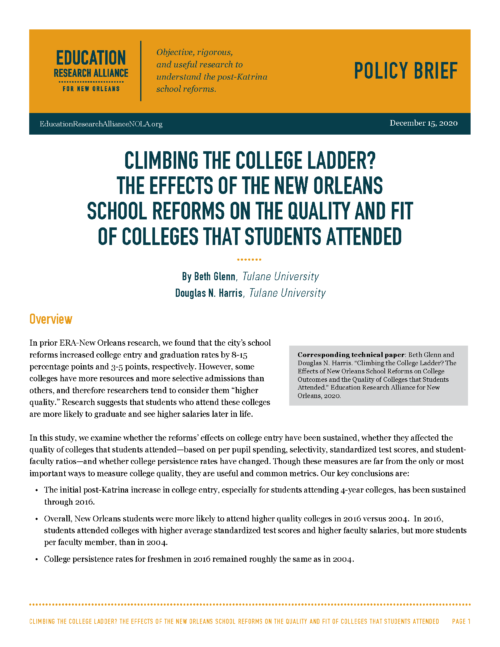Climbing the College Ladder? The Effects of the New Orleans School Reforms on the Quality and Fit of Colleges That Students Attended
A policy brief by Beth Glenn and Douglas Harris finds that the post-Hurricane Katrina school reforms in New Orleans not only increased college attendance rates, but also increased the quality of colleges that local students attended.

Climbing the College Ladder? The Effects of the New Orleans School Reforms on the Quality and Fit of Colleges That Students Attended
Published
by Beth Glenn, Douglas N. Harris
Prior ERA-New Orleans research has found that the city’s post-Katrina school reforms increased college entry and graduation rates by 8 – 15 percentage points and 3 – 5 percentage points, respectively. However, some colleges have more resources and more selective admissions than others, and therefore researchers tend to consider them “higher quality.” Research suggests that students who attend these colleges are more likely to graduate and see higher salaries later in life. In this study, researchers Beth Glenn and Douglas Harris examine whether the reforms’ effects on college entry have been sustained, whether they affected the quality of colleges that students attended — based on per pupil spending, selectivity, standardized test scores, and student-faculty ratios — and whether college persistence rates have changed. Though these measures are far from the only or most important ways to measure college quality, they are useful and common metrics. Their key conclusions are: — The initial post-Katrina increase in college entry, especially for students attending 4‑year colleges, has been sustained through 2016. — Overall, New Orleans students were more likely to attend higher quality colleges in 2016 versus 2004. In 2016, students attended colleges with higher average standardized test scores and higher faculty salaries, but more students per faculty member, than in 2004. — College persistence rates for freshmen in 2016 remained roughly the same as in 2004. Overall, these results reinforce the conclusion that the New Orleans school reforms improved a wide variety of student outcomes, and these improvements persisted a decade after the reforms started. While there were concerns that students were being pushed into colleges they were not academically prepared for, we find that the percent of students who were academically well-matched for their college increased. Nevertheless, there is still much progress to be made, as only around 1 in 8 New Orleans high school seniors in 2009 had graduated from college by 2014. This reinforces the need for policymakers to consider the wide variety of factors that affect student attendance and success in college.
Related Publications
White and Higher Income Students are More Likely to Benefit From OneApp’s Half-mile Admissions Priority
Dec 8, 2020 | by Alica Gerry, Cathy Balfe, Lindsay Bell Weixler
Does Information About High-Performing and Close-to-Home Schools Affect Families' Choices on the OneApp?
Nov 17, 2020 | by Jon Valant, Lindsay Bell Weixler
Do Students Perceive Their Teachers and Schools More Positively When More of Their Teachers Look Like Them?
Sep 23, 2020 | by Alica Gerry, Lindsay Bell Weixler

